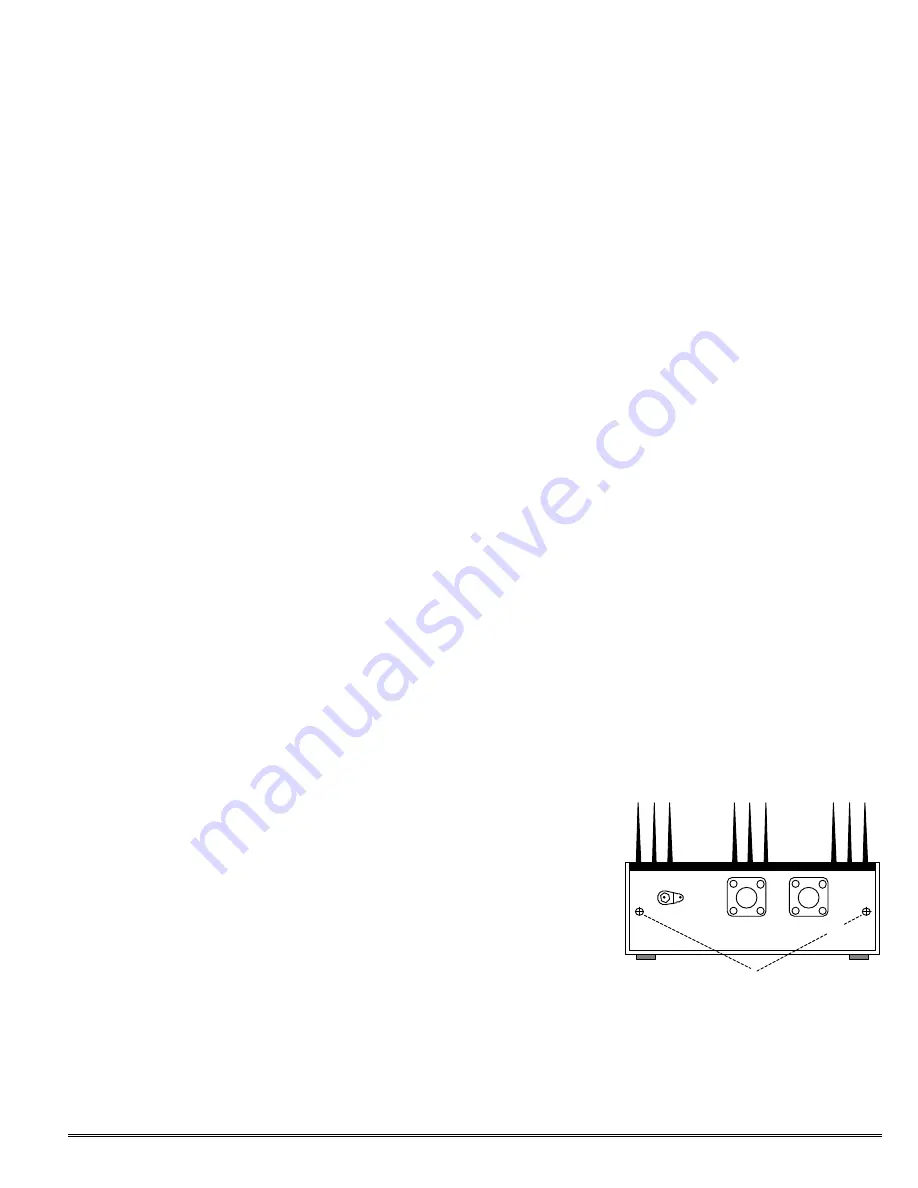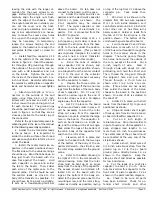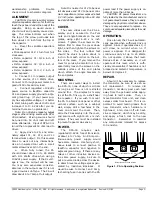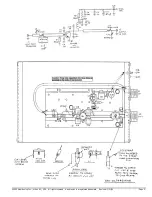
©1995 Hamtronics, Inc.; Hilton NY; USA. All rights reserved. Hamtronics is a registered trademark. Revised: 1/31/00
- Page 3 -
workmanship problems. Double
check circuit to schematic diagram.
ALIGNMENT
CAUTION: Do not screw rotor screws
of piston capacitors down so far that they
touch the pc board under the body of the
capacitor.
Doing so would cause a
short circuit and possibly cause dam-
age. The screw bottoms out when
the top of the screw protrudes less
than about 1/4 inch from the top of
the capacitor.
a. Preset the variable capacitors
as follows:
•
Mica capacitor C12: 1 turn from full
clockwise.
•
Piston capacitor C1: 5/16 inch of
screw exposed.
•
Piston capacitor C2: 3/16 inch of
screw exposed.
•
Piston capacitor C13: 1/2 inch of
screw exposed.
b. Connect J1 to repeater output
or other source of 10 Watts drive.
Connect J2 through power meter to a
good uhf 50 ohm dummy load.
c. Connect reg13.6Vdc
power source to feedthru capacitor
C14 and power supply ground to adja-
cent ground lug. (If your power sup-
ply has adjustable voltage, it is better
to start tuning with about 10Vdc and
increase it to 13.6 Vdc after you de-
termine there are no problems.)
Note: Do not retune repeater output
stage or other driving source with RPA-
30 connected.
Driving source should
be tuned into 50 ohm load and left
alone afterwards. Input of RPA-30 is
tuned then to present 50 ohm load to
driver.
d. Apply drive to PA, and alter-
nately adjust C1, C2, C12, and C13
for maximum output. Do this several
times to work out any interactions.
Use an insulated tool with a small
metal screwdriver bit in the end.
e. When fully tuned, the PA
should deliver about 30 to 45 Watts
with 9-11 Watts drive when using a
13.6Vdc power supply. If the dc volt-
age is low, the output will be less.
You may also experience consider-
able loss in the output coax if it is not
a good low-loss uhf type. The PA will
draw about 6 to 7 Amp at full output.
Note: It is normal for C12 to be near
full clockwise and C13 to be near mini-
mum capacitance (screw exposed about
1/2 inch) when operating into a 50 ohm
load at 445 MHz.
COVER.
The cover slides over the PA as-
sembly and is secured to the Pem
nuts and angle brackets on the end
plates, using eight 4-40 x ¼ inch
screws. Tighten the screws on the
bottom first to draw the cover down
tight, and then tighten the screws on
the sides. The four rubber feet
should be stuck in place about ½
inch in from each corner on the bot-
tom of the cover. If you remove the
cover for service, be careful not to in-
advertently loosen the screws on the
outside surface of the end plates
which attach the angle brackets to
the end plates.
MOUNTING.
There are several ways to install
the RPA-30, none of which is critical
as long as air flow is not restricted
around fins. The simplest is merely
to set the PA, fins up, on a shelf near
the repeater. If you wish to mount
the PA to a blank rack panel or other
vertical surface, such as a cabinet
wall, simply drill a few holes in the
cover and mount the cover. Then,
slide the PA assembly into the cover,
and secure with eight 4-40 x ¼ inch
screws. (The cover must be installed
to prevent repeater de-sense.)
POWER.
The RPA-30 requires well-
regulated 13.6Vdc, free of transients,
at about 6 to 7 Amp. An 8 Amp con-
tinuous-duty power supply would
have some reserve. Use fairly short,
heavy leads to connect positive to
feedthru capacitor and negative to
adjacent ground lug. If there are any
relays or other inductive devices on
the same power supply, be sure to
put a reverse diode across the device
to absorb reverse voltage spikes gen-
erated by inductive kick-back. It
would be wise to connect an 8 Amp,
fast-acting fuse in series with the PA
power lead if the power supply is ca-
pable of more than 8 Amps.
CAUTION: RF power transistors are
fully tested by the manufacturer and are
not guaranteed because they are easily
damaged by physical or electrical abuse.
They are very expensive to replace. Be
sure to use adequate precautions to avoid
damage.
OPERATION.
Once tuned, the PA will automati-
cally operate when sufficient drive is
applied. Since it operates class C, it
will draw no current when no rf
power is applied. It is designed for
continuous duty at up to 45 Watts.
Do not operate it above that level.
Reduce drive if necessary so it will
operate at this level, which is suffi-
ciently conservative if heatsink is not
blocked and ambient temperature is
below 100 degrees F.
REPAIR.
Should it be necessary to replace
the transistor, be sure to use an ex-
act replacement. To remove old
transistor, carefully peel each lead
away from the pc board while appl y-
ing heat to melt solder. Then, re-
move transistor from unit, and clean
excess solder from board. This is im-
portant to avoid tearing leads from
new transistor when hardware is
tightened. Also, clean off old heat-
sink compound, which may be dirty,
and apply a fresh coat to the new
transistor. Remember to resolder
any components removed for access
to transistor.
C14 - POWER
J2 - RF OUTPUT
Figure 3. PA in Operating Position
Do Not Remove These Screws
J1 - RF INPUT






















